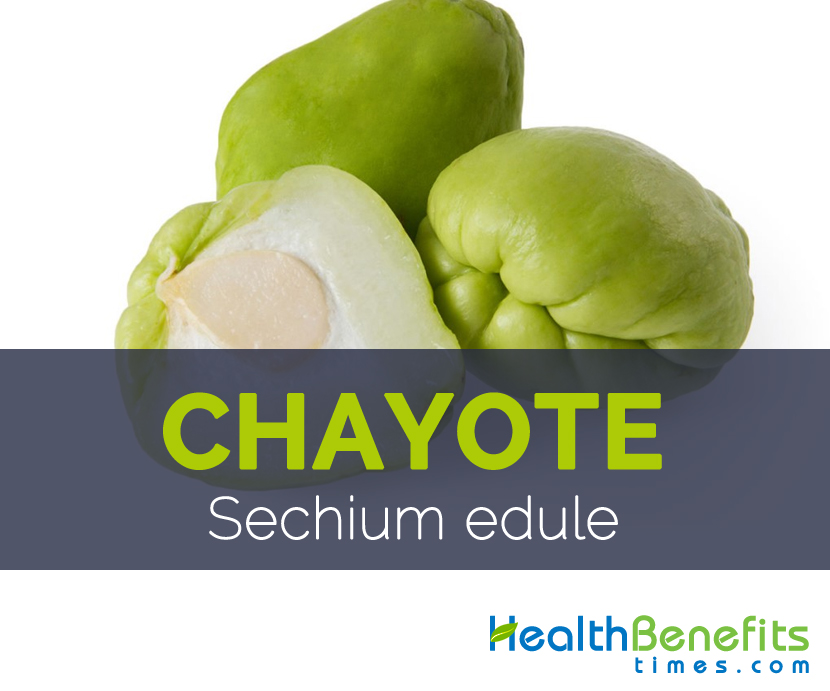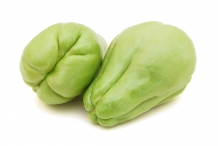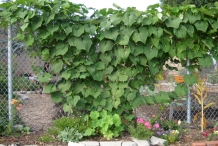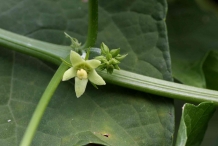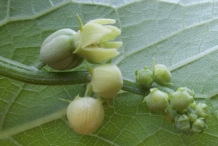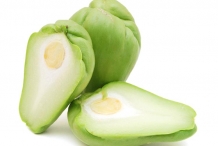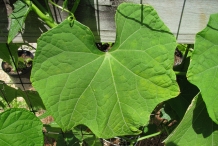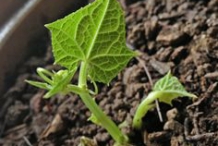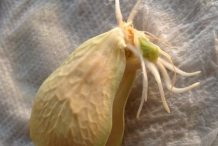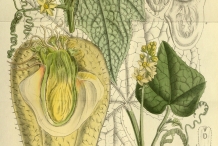| Chayote Quick Facts | ||
|---|---|---|
| Name: | Chayote | |
| Scientific Name: | Sechium edule | |
| Origin | Central America | |
| Colors | Pale green to dark green or brown | |
| Shapes | Roughly pear-shaped, somewhat flattened and with coarse wrinkles, ranging from 10 to 20 cm in length and 7–12 cm wide | |
| Flesh colors | Pale green to whitish | |
| Taste | Mild sweet taste | |
| Calories | 38 Kcal./cup | |
| Major nutrients | Copper (19.56%) Vitamin B6 (14.54%) Vitamin C (14.22%) Vitamin B5 (13.06%) Total dietary Fiber(11.84%) |
|
| Proximity | Amount | % DV |
|---|---|---|
| Water | 149.49 g | N/D |
| Energy | 38 Kcal | N/D |
| Energy | 160 kJ | N/D |
| Protein | 0.99 g | 1.98% |
| Total Fat (lipid) | 0.77 g | 2.20% |
| Ash | 0.61 g | N/D |
| Carbohydrate | 8.14 g | 6.26% |
| Total dietary Fiber | 4.5 g | 11.84% |
| Total Sugars | 3.02 g | N/D |
| Minerals | Amount | % DV |
|---|---|---|
| Calcium, Ca | 21 mg | 2.10% |
| Iron, Fe | 0.35 mg | 4.38% |
| Magnesium, Mg | 19 mg | 4.52% |
| Phosphorus, P | 46 mg | 6.57% |
| Potassium, K | 277 mg | 5.89% |
| Sodium, Na | 2 mg | 0.13% |
| Zinc, Zn | 0.5 mg | 4.55% |
| Copper, Cu | 0.176 mg | 19.56% |
| Manganese, Mn | 0.27 mg | 11.74% |
| Selenium, Se | 0.5 µg | 0.91% |
| Vitamins | Amount | % DV |
|---|---|---|
| Water soluble Vitamins | ||
| Vitamin B1 (Thiamin) | 0.042 mg | 3.50% |
| Vitamin B2 (Riboflavin) | 0.064 mg | 4.92% |
| Vitamin B3 (Niacin) | 0.672 mg | 4.20% |
| Vitamin B5 (Pantothenic acid) | 0.653 mg | 13.06% |
| Vitamin B6 (Pyridoxine) | 0.189 mg | 14.54% |
| Vitamin B9 (Folate, Folic acid) | 29 µg | 7.25% |
| Folate, DEF | 29 µg | N/D |
| Choline | 16.8 mg | 3.05% |
| Vitamin C (Ascorbic acid) | 12.8 mg | 14.22% |
| Fat soluble Vitamins | ||
| Vitamin E (alpha-tocopherol) | 0.22 mg | 1.47% |
| Vitamin K (phylloquinone) | 7.5 µg | 6.25% |
| Amino Acids | Amount | % DV |
|---|---|---|
| Tryptophan | 0.013 g | 2.95% |
| Threonine | 0.05 g | 2.84% |
| Isoleucine | 0.053 g | 3.17% |
| Leucine | 0.093 g | 2.52% |
| Lysine | 0.048 g | 1.44% |
| Methionine | 0.002 g | N/D |
| Phenylalanine | 0.058 g | N/D |
| Tyrosine | 0.038 g | N/D |
| Valine | 0.075 g | 3.55% |
| Arginine | 0.042 g | N/D |
| Histidine | 0.018 g | 1.46% |
| Alanine | 0.061 g | N/D |
| Aspartic acid | 0.11 g | N/D |
| Glutamic acid | 0.15 g | N/D |
| Glycine | 0.05 g | N/D |
| Proline | 0.053 g | N/D |
| Serine | 0.056 g | N/D |
Health benefits of Chayote
Chayote is a roughly pear-shaped, mild flavored vegetable grown worldwide for its delicious seeds, roots, shoots, flowers, leaves and fruit. Almost all parts are consumed raw in salad, boiled, marinated or fried. It is a copper and vitamin B6 rich vegetable which is consumed worldwide to gain more benefits and remains healthy.
- Leaves and fruit have laxative, diuretic, cardiovascular and anti-inflammatory properties.
- Decoctions made from the leaves or fruits are used to relieve urine retention and burning during urination as well as to dissolve kidney stones and to assist in the treatment of arteriosclerosis and hypertension.
- Raw pulp of the fruit is calming for skin rashes and roasted leaves used in the suppuration of boils.
- Herbal tea made with chayote leaves is used for lowering high blood pressure, dissolving kidney stones and treating atherosclerosis, or even hardening of the arteries.
- A tea containing the flesh of chayote squash has mild diuretic properties and is used for treating bloating in certain parts of the world.
https://www.youtube.com/watch?v=pkOAdK8OCjg
How to Eat
- Tuberous roots, fruit, young leaves, shoots and stems are edible.
- Fruit, stems and young leaves and tuber roots are consumed as a vegetable, both alone and plain boiled, as well as an ingredient of plentiful stews.
- Chayote fruit are eaten raw in salads and salsas, but are more often cooked by sautéing or baking or stuffed or boiling, mashed, scalloped, fried or pickled.
- Fruits are used in curries as well.
- Fruit can be halved and bake like a winter squash and serve with butter.
- Peeled sections of the fruit can be cubed for frying or used in soups.
- Due to softness of the flesh, the fruit are used for baby and children’s food, juices, sauces as well as pasta dishes.
- Fully grown light green fruit is cooked as vegetables in China.
- Young fruit and tendriled shoots are used in sayur or are boiled as lalab in Indonesia.
- Fruits are made into kolek.
- Tubers taste like sweet potatoes so cooked as huwi boled and eaten as a delicacy.
- Seeds are edible and are fried or roasted.
- Seeds can be sautéed in butter as a delicacy.
- Chayote is extensively grown for its edible shoot, known as lóng xü cài in Taiwan.
- Shoot is a commonly consumed vegetable in Vietnam and Thailand.
- Teas are prepared from the leaves.
- The large storage roots signify a rich source of starch and are eaten.
- 2 years old tubers from vines are boiled, candied or roasted like potatoes.
- Tubers are eaten like potatoes as well as other root vegetables.
- Shoots and leaves are often consumed in salads and stir fries, especially in Asia.
- Chayote is used in many kinds of dishes such as stir-fried vegetables, soup and chop suey in Philippines.
- Chayote is generally stir-fried in China.
- It is breaded and fried, or used cooked in salads, soups and soufflés in Brazil and other Latin American countries.
- Raw mirlitons cut into chunks/cubes are included in fruit, and vegetable salads.
- In France, it is used as a substitute of artichoke hearts.
- In Puerto Rico, matured fruit are halved and boiled. Seeds are also eaten.
- In India, chayote is consumed with other vegetables in curried dish.
Other Facts
- Starchy tuberous roots and vines are used as cattle fodder.
- Fruit and roots are not only used as food but also as fodder for cattle in America and India.
- Due to its flexibility and strength of the stem fibers, they are used as Reunion, in handicrafts to make baskets and hats.
- Chayote plants are used efficiently in mixed plantations designed specifically for soil recovery and/or conservation in Philippines.
- Flowers are good nectar sources for bees.
Precautions
- Chayote pears exude clear latex like liquid particularly while peeling that can cause peculiar tingling sensation and numbness in handling parts.
Chayote – Sechium edule Facts
Chayote also known as Chaco, Choko is a perennial, monoecious climbing vine which is native to cool mountains of Central America. It prefers well-drained, deep, moist, fertile soil rich in organic matter. It is full of important nutrients like protein, dietary fiber, carbohydrate, vitamins like Vitamin B1, B2, B3, C, E and K and several mineral and amino acids which are extremely for our health.
| Name | Chayote |
|---|---|
| Scientific Name | Sechium edule |
| Native | Cool mountains of Central America |
| Common/English Name | Chaco, Vegetable Pear, Chayote, Cho-Cho, Chayote Squash, Choko, Madeira Marrow, Choco, Custard Marrow |
| Name in Other Languages | Argentina : Cayota El Salvador : Güisquil Slovenian : Čajota Belize : Cho-Cho French Guyana : Christophine Haiti : Christophine Bolivia : Zapallo Japanese : Hayatouri Cuba : Chiote Jamaica : Chiote Puerto Rico : Pipinela Dutch : Groente Peer Eastonian : Tuumkõrvits Brazil : Chuchu Alcaiota Guadeloupe : Christophine Italian : Zucca Czech : Čajot Finnish : Kajottikurpitsa Portuguese : Chahiota Burmese : Gorakha Thee French : Christofine Barbados : Christophine Indonesia : Labu Siam Paraguay : Pap Del Aire Columbia : Chayote (Fruit) Swedish : Kayote Guatamala : Güisquil Danish : Kayote Hawaii : Pipinola Bermuda : Christophine Malaysia : Labu Siam Honduras : Huisquil Nepalese : Iskul Dominican Republic : Tayote Laotian : Taub Thaj Sri Lanka : Chjocho Papua New Guinea : Choko Costa Rica : Pís French Reunion : Chayote Thai : Fak Maeo Maltese : Ċentinarja India: Quash ( Bengali) Peru : Gayota United States : Christophine Khmer : Su-Suu Russian : Cajot Philippines : Chayote Uganda : Ebisusuuti ( Luganda) Nicaragua : Chaya Trinidad and Tobago : Christophine Croatian : Meksički Krastavac English Caribbean : Christoferine Norway : Chavote West Indies : Chiote Slovašcina : Bodeča Buča Ecuador : Achocha Chinese : Chun Jen Kua Turkish : Amcık Kabağı Fiji : Choco Panama : Chayote Vietnam : Su Su Mexico : Apupo |
| Plant Growth Habit | Perennial, monoecious climbing vine |
| Growing Climate | Cool climate, best in full sun with moderate rainfall |
| Soil | Moist, well-drained, deep, fertile soil rich in organic matter. Waterlogged, clayey soil or sandy soil should be avoided. |
| Plant Size | 12 meters or more when support is provided. |
| Root | Thickened tuberous roots that have brown skin and white inside |
| Stem | Slender, branching, grooved angular stems and 3–5 fid tendrils. |
| Leaf | 7 to 25 cm wide leaves are broadly ovate, angled, or slightly lobed and cordate (heart-shaped) at the base and apiculate (tapered) at the apex. The petiole (leaf stalk) is 3 to 15 cm long. The leaves resemble those of cucumber |
| Flower | Small, greenish-white, unisexual, normally pentamerous, coaxillary and with ten nectaries in the form of a pore at the base of the calyx. Axillary racemose inflorescences that are 10–30 cm long, with patteliform calyx consisting of 5 triangular sepals, 5 triangular petals and 5 stamens. |
| Fruit Shape & Size | Roughly pear-shaped, somewhat flattened and with coarse wrinkles, ranging from 10 to 20 cm in length and 7–12 cm wide |
| Fruit Color | White and yellowish, or pale green to dark green or brown |
| Fruit Skin Color | Thin, green skin |
| Flesh Color | Pale green to whitish flesh |
| Fruit Weight | 100-900 gram |
| Flavor/aroma | Mild flavor |
| Fruit Taste | Mild sweet taste that may be comparable to butternut squash or pumpkin. |
| Seeds | Seed is ovoid and compressed with a soft and smooth testa and often germinates within the fruit, nutty flavor, cream-white |
| Varieties | Cabeza de Chango, Chayotillo, Chayote de Caballo |
| Season | September through May |
| Major Nutrition | Copper, Cu 0.176 mg (19.56%) Vitamin B6 (Pyridoxine) 0.189 mg (14.54%) Vitamin C (Ascorbic acid) 12.8 mg (14.22%) Vitamin B5 (Pantothenic acid) 0.653 mg (13.06%) Total dietary Fiber 4.5 g (11.84%) Manganese, Mn 0.27 mg (11.74%) Vitamin B9 (Folate, Folic acid) 29 µg (7.25%) Phosphorus, P 46 mg (6.57%) Carbohydrate 8.14 g (6.26%) Vitamin K (phylloquinone) 7.5 µg (6.25%) |
| Health Benefits | |
| Calories in 1cup (160gm) | 38 Kcal |
References:
https://en.wikipedia.org/wiki/Chayote
http://www.all-creatures.org/recipes/i-chayote.html
http://www.growplants.org/growing/chayote


